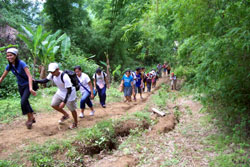City renews drive to reforest Maasin watershed

MAASIN, ILOILO--The Iloilo City government has launched a campaign to help rehabilitate the Maasin watershed, the main water source of the province and city of Iloilo.
Environmental groups, civic organizations and business firms have joined treks to the watershed to draw attention to the critical situation of the area and the need to support protection and rehabilitation efforts.
City Environment Officer Noel Hechanova pointed out that the city's residents are dependent on the water coming from the watershed and should be involved in ensuring the long-term supply of water.
Water rationing has been implemented in the city for the past few years during summer because of the low water level coming from the watershed.
The Metro Iloilo Water District (MIWD), the sole water distributor of the city, extracts water from the Tigum River through an intake dam in Barangay Daja in Maasin town 29.5 km northwest of Iloilo City. It also gets its supply from seven pumping stations in deep wells in Oton and San Miguel.
It provides around 1.2 million cubic meters of water monthly to around 26,000 customers in the city and the towns of Oton, Pavia, Santa Barbara, Cabatuan, Maasin and San Miguel.
Hechanova said the water shortages experienced during summer could worsen with the increase in population and the global climate change.
The watershed reservation covers an area reaching 6,738.52 hectares spanning 16 barangays in the towns of Maasin, Janiuay and Alimodian. It was created on Feb. 12, 1923 by virtue of Presidential Proclamation No. 16.
Wilfredo Canto, protected area superintendent, said that of the total area, only around 1,920 ha are natural forests. Around 3,400 ha have been identified for reforestation programs since the 1990s.
The area was uncultivated forest until World War II when it was used as a resettlement area of residents fleeing occupation troops. Many of the settlers decided to stay in the mountains because of its rich resources, according to Canto.
At present, there are around 40 families living inside the protected area. While they have encourage families to live outside the protected area, many residents outside the perimeter have encroached the area to cut and trees and practice kaingin (slash and burn) farming.
Canto said kaingin farming could not be easily stopped because this is the only source of income for many farmers. The trees which were planted in the 80s and 90s have also matured and have attracted those interested in cutting these trees.
Canto said the current six forest guards could not keep continuous watch ton such a large area. He said they need at least 16 guards who can work in shifts.
Aside from increasing the forest guards, regular visits and treks of environmental groups and advocates in old growth areas could also help ward off potential intruders.
Canto said they are also appealing to the academe, civic groups and business firms to help in the rehabilitation efforts by adopting an area within the reservation and fund rehabilitation and preservation projects under the supervision of the Department of Environment and Natural Resources.
He said these groups could also support alternative livelihood projects for residents living inside or near the protected area so that they will be drawn away from activities harmful to the watershed.
